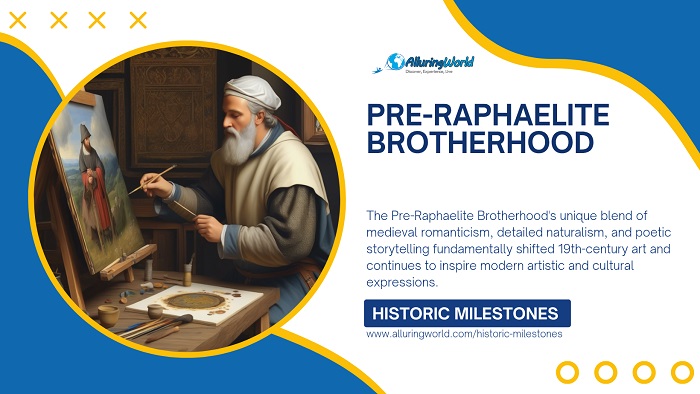Read time ca. 5 minutes
Founded in 1848 by a group of young British artists, the Pre-Raphaelite Brotherhood (PRB) sought to challenge the academic art establishment and return to the intricate detail, vibrant color, and emotional depth of medieval and early Renaissance art, and as they were rejecting the ideals promoted by the Royal Academy, they aimed to restore sincerity, nature-inspired beauty, and moral storytelling to their work. Their paintings often depicted medieval legends, biblical themes, and poetic subjects, reflecting a deep appreciation for historical aesthetics and romanticism.
A Rebellion Against the Academy:
The Royal Academy in the mid-19th century was a stronghold of artistic convention, defending the elegant and idealized style based on the High Renaissance masters, particularly Raphael. This strict adherence to conventions produced a style that the Pre-Raphaelite Brotherhood believed was contrived and at variance with actual observation of nature, and the Academy’s emphasis on formulaic approach and ideal forms, as they perceived them, stifled artistic originality and truthfulness, and the creation of an interceding wall between art and immediate, unmediated contact with reality.
In contrast, the Pre-Raphaelites resolved to shatter these academic constraints, instead advocating a return to the meticulous and realistic observation of nature. They took directly from the pre-High Renaissance artists, such as Jan van Eyck and Fra Angelico, whose work demonstrated a deep respect for close observation, rich color, and intricate compositional structures. This deliberate rejection of the Royal Academy’s principles attempted to bring fresh vitality to British art by emphasizing sincerity and accuracy, ultimately developing a style which celebrated the intricacy and beauty of nature with plain fidelity.
Medievalism and Literary Inspiration:
As the Pre-Raphaelite Brotherhood was attempting to transform the art, they involved themselves with the rich texture of medieval thought, reclaiming a style that romanticized the chivalric age. This fascination with the past expressed itself in their work in the imagery of illustrations of Arthurian romances, Gothic literary references, and the idealized world of chivalry, creating a pictorial language evocative of ancient grandeur and mysticism. They further attempted to overcome the presumed sterility of modern art by embracing the emotional richness and narrative possibilities of medieval chronicles, effectively taking people to a world of idealized history.
Besides that, the Pre-Raphaelites created a strong connection between their artistic visual work and their literature and were influenced by Dante Alighieri and John Keats’ poetry. Through their interdisciplinarity, their paintings became infused with rich literary symbolism that made their works visual narratives which described the emotional and thematic richness of their literary sources. Such familiar figures as Ophelia, The Lady of Shalott, and knights of the Middle Ages were the recurring themes, serving as conduits for the Pre-Raphaelites’ desire to integrate art in a harmonious union with poetic and historical narratives, thereby imbuing their art with several layers of literary and historical significance.
Key Artists and Their Works:
The origin of the Pre-Raphaelite Brotherhood was marked by the special contribution of each of its three original members: Dante Gabriel Rossetti, John Everett Millais, and William Holman Hunt. Millais, in his masterpiece Ophelia (1851-1852), represented the Pre-Raphaelite commitment to realistic detail and psychological intensity and brought with vivid intimacy to life the tragic loveliness of Shakespeare’s heroine against the meticulous natural scene of the artist. Hunt’s The Light of the World (1853-1854), on the other hand, proved the group capable of profound spiritual symbolism, inserting religious allegory into a highly detailed visual field. These disparate approaches established the Pre-Raphaelite focus upon both naturalism and symbolic intent.
Rossetti, the third cornerstone of the Brotherhood, added to the movement his own combination of sensuality and mysticism, as seen most notably in his idealized renderings of women. His paintings, infused with a dream-like quality and concern for female beauty, acted as a transition from the Pre-Raphaelite ideals to the developing aesthetic movements of the late 19th century. Through the emphasis on emotional intensity and subjective beauty, Rossetti expanded the Pre-Raphaelite vision beyond its initial concern with naturalism, providing an opening for the quest for more abstract and symbolic forms of artistic expression.
Impact on Victorian Art and Beyond:
Despite a negative critical reception at first, the Pre-Raphaelite Brotherhood eventually gained acceptance, leaving an enduring mark on Victorian art, literature, and design. Their emphasis on naturalism, medieval themes, and literary models appealed to more and more individuals, shaping the aesthetic values of the time, and the movement’s tenets, initially controversial, soon became a significant force in British cultural life, influencing not only painting but the broader artistic environment.
Also, the Pre-Raphaelite ethos evolved into the Aesthetic Movement of artists like Edward Burne-Jones and William Morris, and the movement included the application of the principles of Pre-Raphaelite art to the realm of decorative art and textile design, with an aesthetic that permeated much of Victorian life. Their legacy lives on in contemporary culture, especially in fantasy illustration, book cover design, and popular culture’s romanticized visions of medievality, demonstrating the enduring power of the Pre-Raphaelite imagination.
Conclusion:
Overall, the Pre-Raphaelite Brotherhood’s devotion to medievalism, nature, and poetic storytelling set them apart from their contemporaries and left an enduring mark on art history. By rejecting academic conventions and embracing a romanticized vision of the past, they redefined artistic expression in the 19th century, and their work continues to captivate modern audiences, offering a window into a world where beauty, symbolism, and history intertwine.

